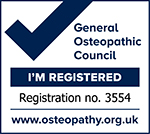
Commonly people come to see an osteopath complaining of hip pain. This can be located in the buttock, groin or outside of the hip. The pain can be referred from the lower back or joints within the pelvis, or from structures within and around the hip itself. Pain from the hip itself can also refer to the knee and ankle.
The osteopath will first determine what is the cause of the pain, by taking a detailed case history and examining the spine, pelvis and hip. The next stage is to develop a management plan which may include osteopathic manual therapy, advice about what exercises might be helpful, as well as any activity modification.
Very often hip pain can come about as a result of abnormal biomechanical balance around the lower back, pelvis and hip. The osteopath, by using a variety of techniques such as joint manipulation, muscle energy techniques and soft tissue release including trigger point therapy, would hope to reduce strain to the joints and thus ease pain.
There can be other causes of hip pain, some of which include;
Osteoarthritis.
With osteoarthritis in the hip, cartilage wears away, and bony growths may start to grow outwards (osteophytes). There may be some mild inflammation around the hip joint. The symptoms of osteoarthritis generally developed slowly and worsens with time, and include;
- pain in your groin that can radiate to buttock or knee
- a decreased range of motion and stiffness that affects the ability to walk and may cause a limp
- pain that flares up with vigorous activity
While we cannot undo the wear and tear process, osteopathic manual therapy in conjunction with correct exercise rehabilitation may give some relief.
Greater trochanteric pain syndrome (GTPS)
This is a common condition usually characterised by pain along the outer side of your hip/thigh/buttock. It is usually caused by an injury or irritation to the soft tissue structures that lie over the top of the outside of the hip bone (the greater trochanter). It could either be a bursitis or an injury or irritation of the gluteal tendons (gluteal tendinopathy).
It affects women more commonly than men and is more common for people aged 40-60.
Pain can often be felt with any of the following;
- lying on your side
- sitting with crossed legs
- exercise eg walking, climbing stairs
- sitting for long periods
GTPS can to take a while to improve, and in some cases it can take several months. However with osteopathic treatment we would aim to reduce friction in the structures at the outside of the hip. Treatment is multifaceted and would include the following;
- osteopathic manual therapy – hands on therapy to restore balance to the pelvis and reduce muscular tension around the hip.
- activity modification. Avoid doing the things that can provocative it such as sitting crossed legged, or for long periods.
- exercise modification. After initial rest try to exercise in a way that puts less stress on the area, such as swimming instead of running.
- exercise rehab – strengthening and stretching of important muscle groups
Femoroacetabular (hip) impingement (FAI)
In FAI bony growths can develop around the edge of the socket (acetabulum) or the femoral head (to of the thigh bone that meets the socket). This extra bone can cause the edge of the ball and socket to contact abnormally, which can cause pain and tears in the labrum (the ring of cartilage around the socket). Symptoms are usually pain and stiffness in the groin, with sometimes sharp and stabbing pains from turning twisting or squatting.
Non surgical treatment might include activity modification, exercises to strengthen around the hip to help support the joint, and manual therapy to help reduce mechanical strain to the joint. Some nonsteroidal anti-inflammatory medications prescribed from your GP may help in the short term to help calm things down. In cases which don’t settle, there are surgical options that can help for which your GP can refer you for.



